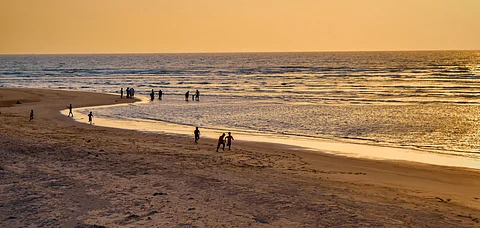
- Destinations
- Experiences
- Stay
- What's new
- Celebrating People
- Responsible Tourism
- CampaignsCampaigns
- SubscribeSubscribe
- Buy Now

After a rather intensive sightseeing spree around Ratnagiri town in Maharashtra, the cool confines of the Swami Swaroopananda Math were such a relief. It was while talking to a devotee at the ashram that we came to know of a centuries-old Sun temple in a small village tucked away in the Konkan belt.
Worship of the sun god has been popular in India since time immemorial. There are several sun temples in India, among which the most famous are the Sun Temple of Konark (in Odisha)&ndasha UNESCO World Heritage Site, the Modhera Sun Temple (Gujarat) and Martand near Anantnag (Jammu and Kashmir). But not many have heard about the Kanakaditya Temple in Ratnagiri district of Maharashtra.
Driving through the picturesque Konkan countryside, we arrived at a village called Kasheli, about 25km from Pawas. Although there is no record as to when the temple was built, according to local people the temple is over 800 years old. The origin of the temple lies in a legend.
A boatman travelling from the port of Veraval (Gujarat) on the Arabian Sea was sailing in the southern direction. A local priest had entrusted him with an idol of the Sun god fearing an attack on the temple where it was housed. A few days later, when the boat neared Kasheli, the wind dropped. When he failed to steer the boat into the sea, the boatman thought maybe it was because of the idol he was carrying. So he placed the idol in a cave nearby and soon after that he was able to sail away. Meanwhile, a woman called Kanaka who resided in Kasheli and was a worshipper of the sun, learned of the idol in the cave in her dream. With the help of the villagers, she built a small temple and installed the idol within it. Soon it became popular as Kanakaditya meaning Kanaka&rsquos Aditya (Aditya is another name for the sun in Sanskrit).
A narrow village road led to the temple lying in a fairly habited area. The main gate led to an enclosed courtyard. The temple was made of locally available red laterite stones. The building looked like a Konkani hut with sloped roof. Inside the sanctum was a black stone idol with large eyes. A silver crown representing the sun adorned the idol. The roof was decorated with painted carvings of various gods and goddesses.
In front of the temple was a large hall or the Sabha Mandap, decorated with wooden pillars and paper craft. There were other smaller temples within the complex, a well and many small podiums containing the &lsquoTulasi&rsquo plant.
In a corner of the temple was a small chariot. During our time of visit, it was being repainted and readied for the temple&rsquos biggest festival held on the day of Mitra Saptami. Although the festival is held in many places in India (usually in February), here the sun god is taken out in a chariot procession on a tour of the village.
We whiled away our time at the temple. In the afternoon, when the temple is bereft of visitors, some of the senior members of the village sit here to keep a vigil. Towards late afternoon, we paid a visit to the nearby Devghali beach. It was at a cave here that the idol was discovered by Kanaka. The cave is known as &lsquoDevachi Kholi&rsquo. The cave can be reached only for a short time when the water recedes and is best visited with a villager for a guide.
A trip to Kasheli can be combined with a visit to the old Mahakali Temple at Adivare, three km away.
Getting there Kasheli village is about 30km by road from Ratnagiri. It can be part of a circuit covering Pawas and Adivare. Best to visit early in the day or late in the afternoon to avoid the heat. Carry drinking water.
